With the release of the 10th edition Codex: Tyranids tomorrow we have our first major lore update to 10th edition since the release of Leviathan and it’s a good time to dig through the book to look at what’s new in the book, the lore of the hive fleets, and what plot hooks have been laid for future developments. This also serves as a good coda to our series of articles on Tyranids, in which we’ve looked at the history of the Tyrannic Wars, the Genestealer Cults, and the goings on of War Zone Valedor and War Zone Octarius.
The Great Devourer
The Tyranids are a semi-insect like race of alien predators who are threatening the galaxy from beyond its edges. In that sense they’re unique in that they aren’t a threat from the Milky Way but instead have traveled the vast distances across the interstellar void to attack from some other galaxy – and some Imperial scholars believe this is because they just already consumed that entire galaxy and had to move on. Closely associated with this is the observation that the Tyranids seem to be a race entirely designed and adapted for making war, suggesting they may have been engineered at one point rather than created through natural evolutionary processes.
Even if they weren’t naturally created through evolution, that is the operative word to focus on with Tyranids – their biggest advantage/feature is their ability to rapidly adapt and evolve to counter threats. As they consume organic material and fight battles, they absorb the traits of their defeated foes and use this along with the learned behaviors from their battles to adapt new bioforms, tactics, and weapons for defeating their enemies faster and more effectively.
Compared to the other races of the 40k universe Tyranids are at once both technologically inept and highly advanced; while they do not build or invent technology in a traditional sense, their weapons, ships, and wargear are entirely biological, made of highly adapted symbiotic life forms, often grafted to their hosts for use in war. Likewise, even Tyranid ammunition is organic, and can include things like “small, incredibly hard beetles that burrow into your skin after contact and explode in a shower of acid.” It’s grim stuff, but leads to some very cool visuals – Tyranid spaceships are massive, tentacled beasts adapted to survive and travel through the void.
On that note, it’s worth talking about Tyranid intelligence – Tyranids largely share a hive mind, a gestalt consciousness of sorts that governs Tyranid actions and is shared through a series of larger creatures called Synapse beasts. This consciousness itself is intelligent and terrible, and its psychic presence casts a massive Shadow in the Warp which interferes with psychic activity and makes communication across those areas impossible. While Tyranids are capable of a degree of individual thought and intelligence, most of this behaviors is either instinctual (something that can be seen when smaller entities are removed from the Synaptic influence of larger bioforms), or given in small measure to its agents which require some level of autonomy – in particular, the Swarmlord, a creature which acts as the Tyranids’ field commander.
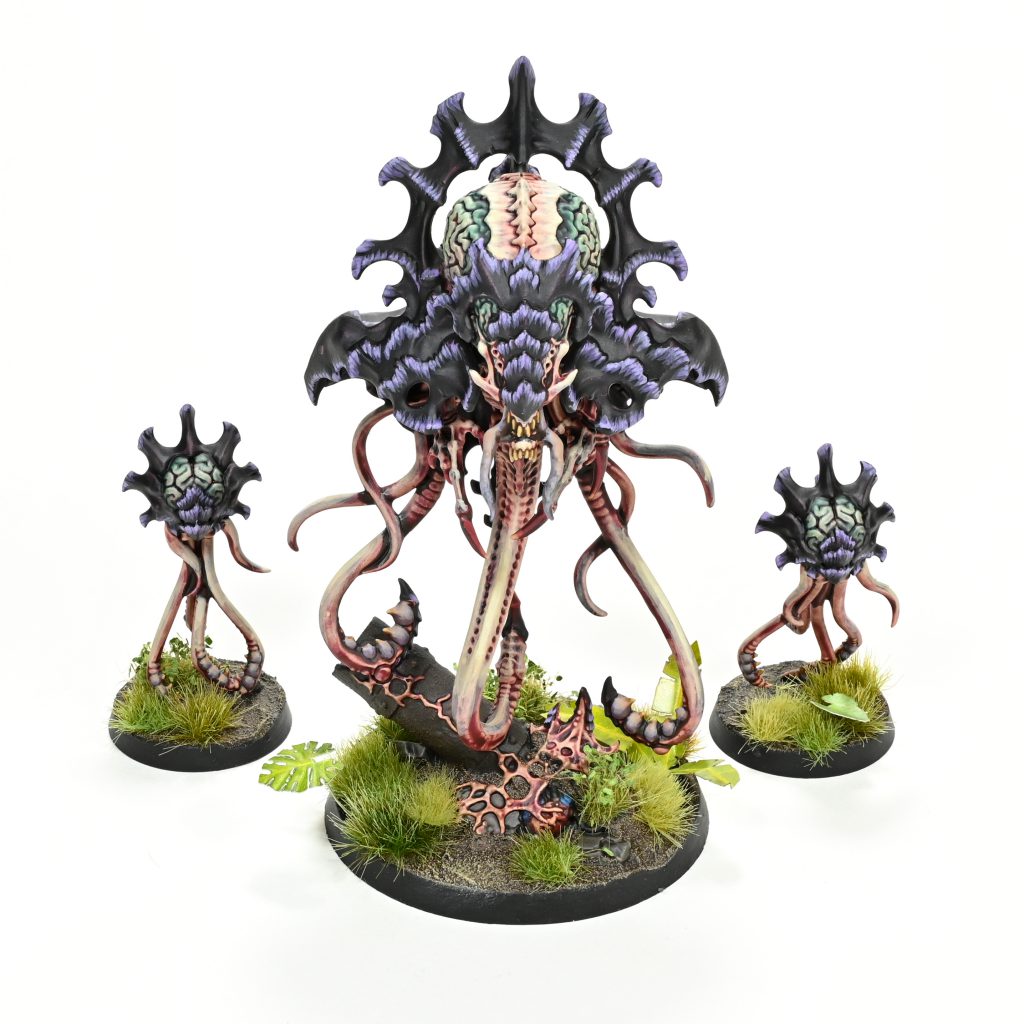
The Shadow in the Warp
Tyranids don’t interact with the Warp in the same way as the other races of the 40k universe. In a lot of ways Tyranids appear to be psychically inert, and can travel through the warp (via rifts) unscathed. As they travel, the shadow cast by the hive mind stretches out in front of them, stilling the warp in all directions and interfering with beings’ connection to the empyrean. For regular beings, this can have the effect of making them anxious and paranoid – often helping to sow panic prior to a Tyranid invasion.
For psychic beings, the Shadow in the Warp is a much bigger deal, creating a kind of “static” that fills their thoughts and messes with their minds pretty bad. Trying to manifest psychic powers in this shadow can lead to some nasty consequences, like bloody noses, madness, and exploding heads. The Tyranids themselves seem largely unbothered by all this and have been adapting lifeforms and ways of siphoning and using the power of the Warp to lethal effect on battlefields.
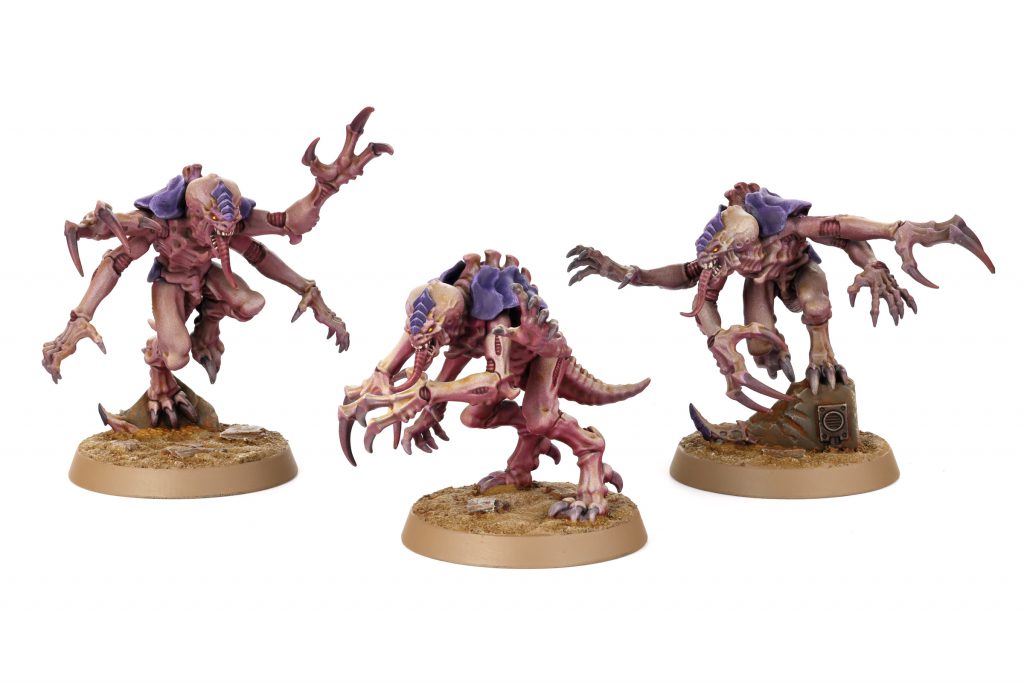
Tyranid Origins
Not a lot is known about who the Tyranids are or where they come from, and the lore largely keeps things mum on that front. What’s known is that they come from beyond the galaxy, they devour everything they come across, and they seem utterly unified in the purpose of doing so. How and why the Tyranids ended up in our galaxy can likely be attributed to actions taken during the Horus Heresy. Specifically when (Loyalist) Iron Warriors Warsmith Dantioch overloaded the Pharos Beacon, a kind of “interstelllar lighthouse,” to save one of his friends in the Imperial Fists. This destruction sent massive psychic shockwaves out into the void where it eventually reached the Tyranid fleets traveling through interstellar space, calling them like a moth to flame.
There’s a fair amount of in-universe conjecture and hearsay about the Tyranids and there are some Imperial records that suggest some previously thought-to-be indigenous lifeforms across the galaxy are the remnants of ancient hive fleets. This largely scans with the idea that Genestealers had been known about for a long time before the Tyranids invaded, and suggests there may have been conflicts with them in the past.
Whatever their origin, it largely doesn’t matter – what matters is that the Tyranids aren’t from here, they aren’t going to be friends with anyone, and they’re not going to be stopped.

First Contact
This is something we’ve gone into greater detail in our Lore Explainer on the Tyrannic Wars but we’ll give the Cliff’s Notes version here: The Tyranids were first discovered when they attacked the planet Tyran Primus (hence their name), and information about the invasion and their capabilities was collected and taken back to the Imperium by Inquisitor Kryptman. This was the start of what would be the First Tyrannic War, in which Hive Fleet Behemoth launched its first incursion into the galaxy, to be ultimately stopped by a valiant effort from the Ultramarines at Ultramar.
Since then there have been three more Tyrannic Wars and we’re currently in the middle of the Fourth, featuring the return of Hive Fleet Leviathan, this time attacking Segmentum Pacificus from a point orthogonal to the galactic disc. This new invasion is more dire than previous ones, in part because it’s closer to Segmentum Solar and Holy Terra than was previously thought possible. This early initial fighting comes to a head on the world of Sanctum, the home world to the White Templars space marine chapter. Through the coordinated efforts of imperial forces led by Lord Solar Leontus, the Imperium managed to turn back the Grendyllus Tendril of Leviathan, but it’s clear that the Fourth Tyrannic War is only just starting.
Tyranids vs. Chaos Notes
There are some fun notes in the 10th edition Tyranid Codex about Tyranids going up against Chaos. The first of these details Hive Fleet Leviathan being scattered and tossed into Warp Storms after losing at Baal and the Great Rift opening. Now they’re largely hanging out in the Maelstrom and fighting the Red Corsairs, who have to contend with an opponent who are largely unaffected by the warp storm. The second covers World Eaters rushing to meet Hive Fleet Kraken on the Eastern Fringe, with Orks and Drukhari soon joining in as well.
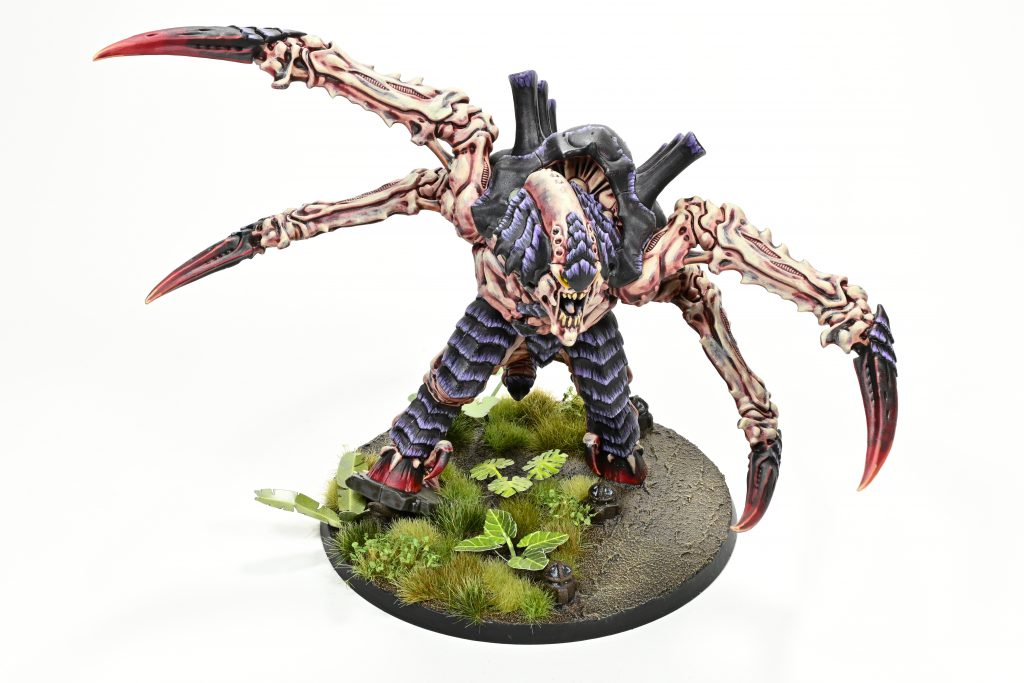
Tyranid Hive Fleets
Tyranid forces are split into a number of hive fleets, massive swarms of organisms that travel in groups on their paths to devour the galaxy. Though they vary in size, composition, and behavior they’re similar in that they travel in massive voidborne hive ships, living spacecraft which carry their swarms across the void. These hive ships play host to Norn-Queens, highly intelligent Tyranids which act as the ultimate commanders and birthing engineers of the fleet. These creatures ingest the captured genetic material from the Tyranid invasions and use it to create new bioforms for the swarm. Which bioforms it chooses to create and how will depend on the needs of the fleet, the material captured, and the enemies it faces.
These fleets are incredibly difficult to destroy, as even when defeated in battle, they can often split into a number of smaller splinter fleets which may travel on their own, slipping past Imperial nets and devouring smaller worlds until they can regain their strength, all the while growing smarter and more capable.
There are currently around nine major Hive Fleets documented in the lore, each with their own quirks and methods of battle. At any given time six of these had rules carved out for them in 8th and 9th edition, though as we move into 10th edition fluff the focus is more on the method of warfare via Detachments than the traits specific to each Hive Fleet. These largely serve as the subfactions of the Tyranid lore, though it’s worth noting that unlike for other factions, these don’t war amongst themselves in the same way that say, Blood Axes and Bad Moons might. Sadly, the lore on these has been excised from the 10th Edition Codex: Tyranids.
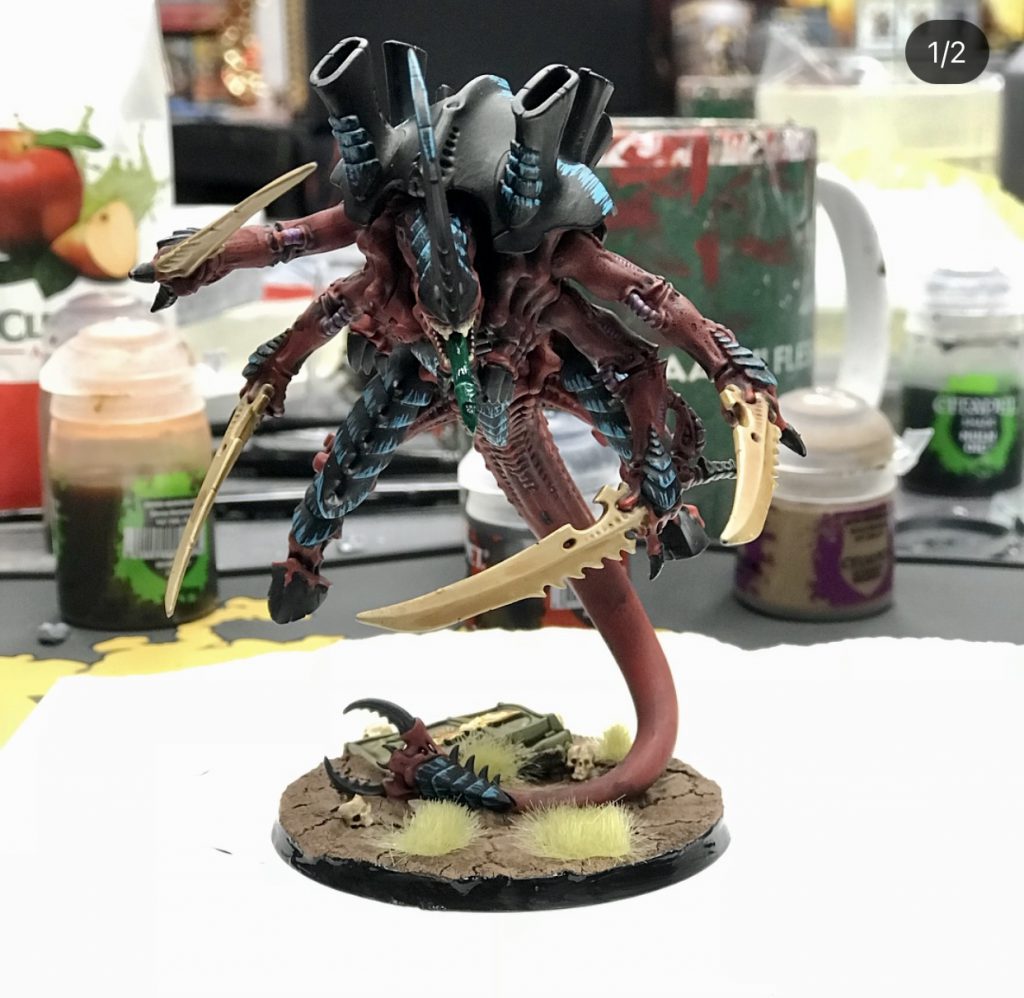
Behemoth
The original Hive Fleet responsible for the “First Contact” incident and the First Tyrannic War, Hive Fleet Behemoth canonically have red skin/bodies with dark blue/black chitinous plating. The swarms of Behemoth are known for being hyper-aggressive, stampeding forward with predatory aggression and uncontrollable hunger, devoid of subtlety. Although ultimately defeated at the Battle for Macragge, Hive Fleet Behemoth survived via a number of splinter fleets which continue to terrorize the Imperium.
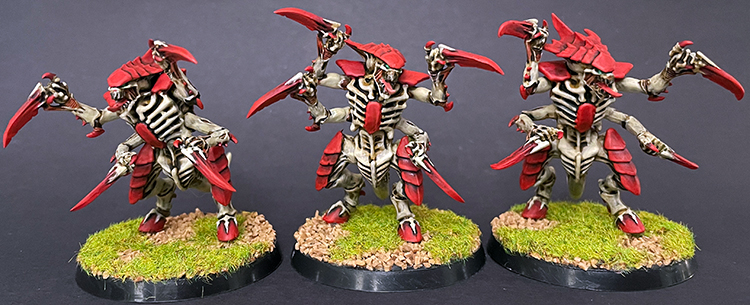
Kraken
The hive fleet behind the second Tyrannic War, Tyranids of Kraken canonically sport bone-colored flesh with bright red carapace armor. The fleet itself consisted of a series of “tendrils,” a series of smaller, separate hive fleets more spread out than the blunt attack of Behemoth. In contrast to Behemoth, the methods of Hive Fleet Kraken are much more devious, typically dedicated to outmaneuvering and encircling prey before making the killing blow. Ultimately the advance of hive fleet Kraken was defeated by the combined efforts of the Imperium and Aeldari forces – most notably those of Craftworld Iyanden.
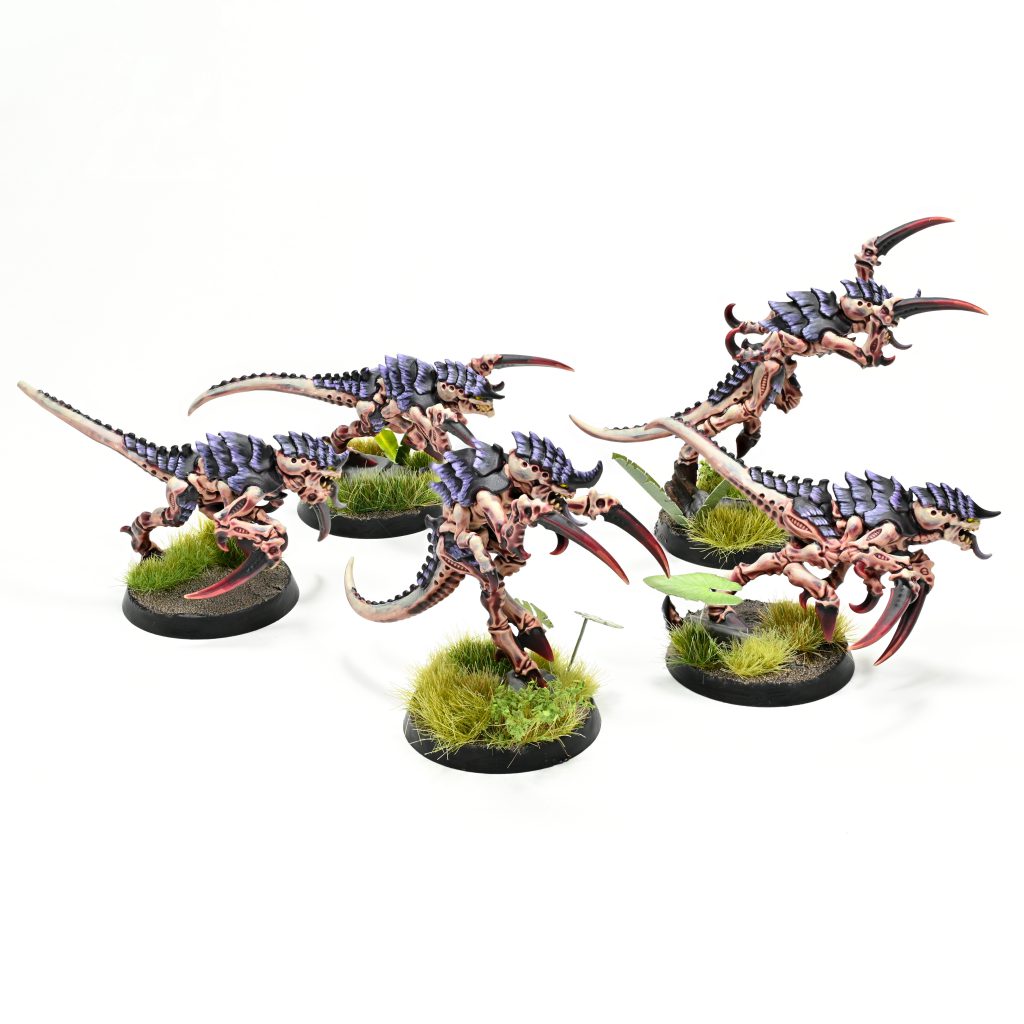
Leviathan
Leviathan are the current poster children of the Tyranid faction and 10th edition Warhammer 40k, sporting white flesh with purple armor. They’re responsible for the third and fourth Tyrannic Wars, and are notable for attacking “vertically” from “beneath” the galaxy rather than perpendicular to the galactic plane. In battle the Tyranids of Leviathan are known for being the most adaptable predators seen yet among the hive fleets, and have honed their skills by trial and error.
Gorgon
The Tyranids of Hive Fleet Gorgon have a more muted green-and-bone color scheme, and are known in battle for using adaptive hypertoxins, weaponized spore clouds, and corrosive poisons to destroy their enemies. Their assault comes from the eastern fringe of the galaxy, and they’ve made it a priority to attack Agri-Worlds, potentially tainting foodstuffs with dangerous spores before they’re shipped off throughout the galaxy.
Jormungandr
The Tyranids of Hive Fleet Jormungandr canonically feature black flesh with yellow armor plating. In battle they tend to favor subterranean assaults and surprise attacks, often striking from below when enemies least expect it. They often preface ground attacks by bombarding prey with debris from orbit, and lace the debris with broods of tunneling bioforms to burrow beneath the surface of their target planet on impact. Hive Fleet Jormungadr gained its name from the way it spread out around the Thalassi Sector like a massive serpent, sealing off the sector before constricting inward and devouring its prey.
Kronos
The Tyranids of Hive Fleet Kronos resemble a sort of inverted scheme of Hive Fleet Behemoth, with dark blue/purple flesh and red armor plating. The Tyranids of Hive Fleet Kronos are notable for the way they’ve adapted to fighting and dealing with Daemons. The denizens of the warp are terrible enemies for the Tyranids; they fight ferociously yet provide no sustenance nor biomass for the fleets to consume and so must be dealt with in a different fashion. The Tyranids of Kronos specialize in long-ranged attacks and assaults through the warp, while their arrival is prefaced by an even more powerful and expansive shadow in the warp. Hive Fleet Kronos often follows behind Leviathan, but recently has been working its way along the Great Rift, attempting to destroy Chaos-corrupted systems that might otherwise be a threat to the progress of the fleets.
Hydra
These Tyranids sport a darker purple-flesh-with-black-plates color scheme and are one of the more recent arrivals to the galaxy. The fleets of Hydra are scavengers, devouring the shattered remains of other splinter fleets and defeated tendrils as they work toward the galactic core. In battle they swarm enemies with massive presses of smaller bioforms whose numbers seem endless.
Tiamet
Hive Fleet Tiamet canonically have light blue-green flesh with darker teal armor plating and are known for being adapted to defensive warfare. Specifically, they’re known for having diamond-hard chitinous shells and highly regenerative flesh and attacking in overlapping waves capable of withstanding tremendous firepower. They’re named for the Tiamet system where they were discovered, and it’s in the center of this system where they’re building some kind of massive biostructure that seems to be broadcasting a psychic scream with greater and greater intensity.
Ouroboris
These Tyranids sport bright blue flesh with dark gray armor plating in their official paint scheme and specialize in aerial attacks and airborne predation. Imperial scholars have theorized that the Tyranids of this fleet are the oldest of their kind and appear to have less refined bioforms compared to other more recent fleets. This can be as much of a benefit as a hindrance however, as strategies and tactics developed against other fleets will often be ineffective against those of Hive Fleet Ourboris.

Notes
Originally Tyranids had a very bright, varied color scheme that tended toward red skin with bone armor plating but wasn’t nearly that cohesive – genestealers and hormagaunts were purple and blue, warriors and termagants were red and bone, zoanthropes, carnifexes, and hive tyrants were red and purple with bone-colored plating, and lictors were a bunch of colors. These would get cleaned up with the release of the Warhammer 40k third edition rulebook, where the studio army featured Tyranids with purple flesh and black armor in the scheme that would later become Hive Fleet Hydra.
When the third edition Codex: Tyranids released, the studio scheme shifted to the scheme used for Kraken, i.e. cream-colored flesh with red armor plating. In 4th edition the purple-and-cream Leviathan color scheme was introduced as the new studio paint scheme for the army and that’s what Games Workshop have used ever since. This was also when the company officially introduced the schemes for Behemoth and Kraken by name.

Key Tyranid Units
Tyranid forces are made of a large number of different units, each adapted to a specific purpose on the battlefield. Each of these have their own lore associated with them, and it’s worth diving into some of these here, particularly with regard to the newer bioforms introduced in the 10th edition Codex: Tyranids.
The Swarmlord
The herald of the hive mind and one of the few Epic Hero/Special Character units the Tyranids have, the Swarmlord is a unique monster created by a hive fleet to act as its leader. These monsters possess a malicious intelligence and on death are absorbed through the Synaptic link and spawned anew, possessing all the knowledge of their defeated self.
Hive Tyrants
While a hive fleet will only have one Swarmlord, the Tyranid forces under him will typically be commanded by Hive Tyrants, massive synapse monsters possessed with a degree of autonomy and strategic cunning. Also, they can have wings.
Neurotyrant
Neurotyrants are psychic monsters who guide the swarms around them with brutal efficiency while radiating the Shadow in the Warp.
Norn Emissary & Assimilator
Norn Emissaries are spawned for a specific strategic purpose at the best of the fleet’s Norn-Queen, such as killing an important commander or capturing a target with key intel. They’re powerful psychic monsters and massive in size. The Assimilator on the other hand is just a bigger, stronger monster than most.
Final Thoughts
The Tyranids are an interesting antagonist for the 40k universe. They’ve been established as a pretty credible threat by this point, but the fact that they lack any kind of speaking characters means they’re pretty much always relegated to the role of silent antagonist in the lore. At the same time, the fact that they aren’t in danger of losing anyone on a permanent basis and can always have more of their number waiting just outside the galaxy means that they’re almost always on the losing end of bigger stories, and will often be the antagonist that causes erstwhile enemies to team up, such as with the Necrons and Blood Angels during the Third Tyrannic War.
The 10th edition Codex: Tyranids trades out detailed information about each hive fleet in favor of more pages with stories, something that’s supported a bit more by the new edition’s approach to detachments over subfactions. This is a bit of a shame, because the lore on the hive fleets is pretty cool, but also helps avoid players feeling like they have to tie themselves to a particular fighting style for a faction known for adapting and changing things up quickly to suit their needs. It’s an interesting choice but we won’t be surprised if that particular lore resurfaces again at some point, like older lore has a habit of doing.
Have any questions or feedback? Drop us a note in the comments below or email us at contact@goonhammer.com.
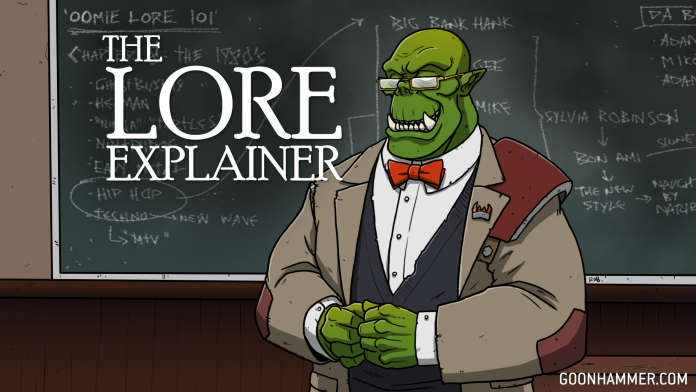
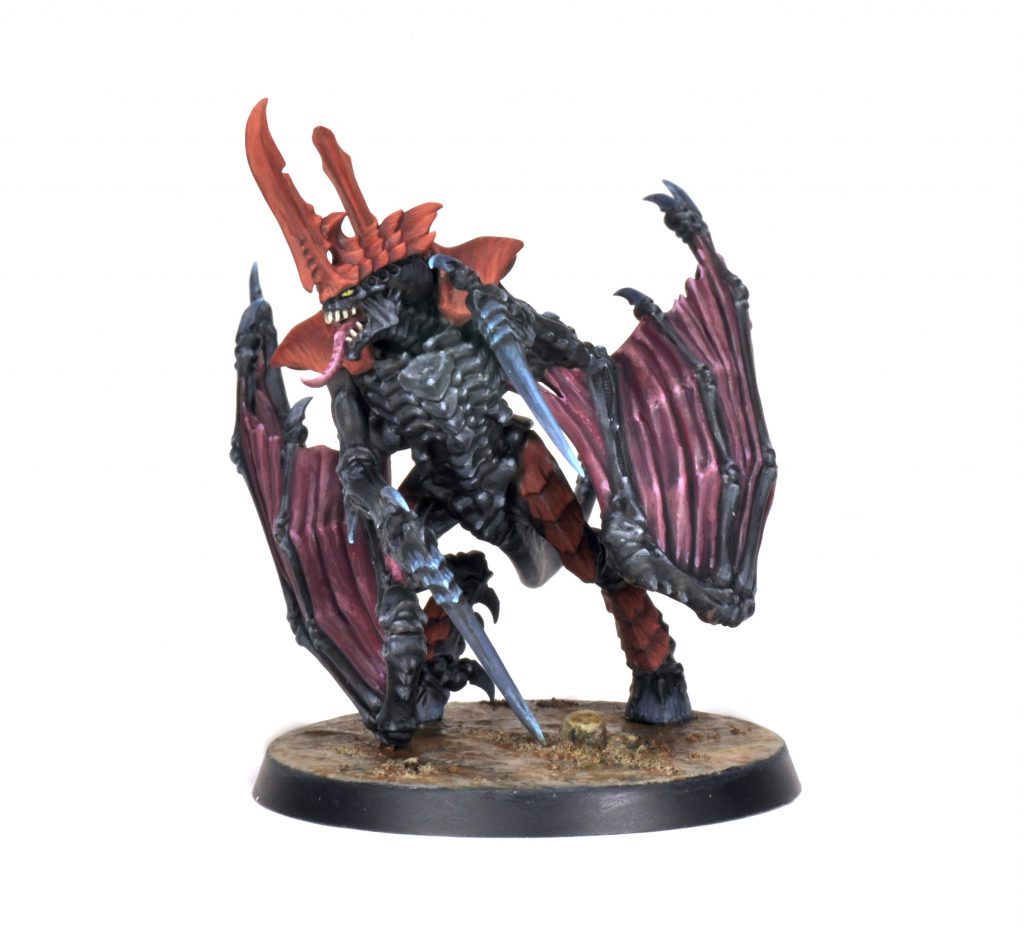


You must be logged in to post a comment.